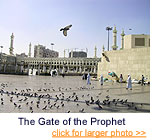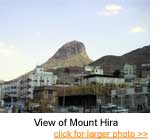For the last two years, with my co-producer, Alex Kronemer, of Unity Productions and an international team of scholars and filmmakers, I've been developing a documentary film for American TV, to tell the story of the life and times of Muhammad, the Prophet of Islam.
One point of this project is to add some actual facts and human feeling to the painful amount of stereotypical thinking in this country about Islam. As it happens, a reasonable telling of Muhammad's story can go a long way to clearing up these misapprehensions, because Muhammad's life is exemplary in many ways. Muslims still look to his biography on a daily basis to guide them, to inform them, to improve the texture and meaning of their lives. Non-Muslims might look to it too, to get a feel for what Islam means in the daily lives of the American Muslims now all around them. America is home today to six million Muslims and counting. Yet most Americans, I dare say, don't even think of Islam as a religion, as a practice of various ethics and rituals in average people's everyday lives. Perhaps a television documentary would contribute something to improving this situation.
But to film anything well, you have to scout locations first. That is why I've come to Mecca from Northern California, to explore the ground where Muhammad lived and taught 1,400 years ago: 12,000 miles, 22 hours at 30,000 feet, to spend some days in Arabia tracing the footsteps of a prophet.
 Few outsiders realize how deeply this desert land is marked by the actions and words of this man who lived here 14 centuries ago. Muhammad was born in a quarter of Mecca on the flanks of Mount Qubays. Today, this part of town is covered by a few acres of forecourt laid in marble. Across the way, there stand a dozen gates leading into Mecca's famous mosque. One is called the Gate of the Prophet, because Muhammad crossed that way from his home to the shrine. He would have only had to walk a hundred yards.
Few outsiders realize how deeply this desert land is marked by the actions and words of this man who lived here 14 centuries ago. Muhammad was born in a quarter of Mecca on the flanks of Mount Qubays. Today, this part of town is covered by a few acres of forecourt laid in marble. Across the way, there stand a dozen gates leading into Mecca's famous mosque. One is called the Gate of the Prophet, because Muhammad crossed that way from his home to the shrine. He would have only had to walk a hundred yards. I'm here today with my co-producer, Alex Kronemer, film director Omar Al-Qattan, and Dr. Angawi, our friend and guide. Dr. Angawi is an architect. He describes himself as viewing the world through two eyes, one fixed on the city of Mecca, the other on Madinah, the two sacred cities of Islam. His family history is intertwined with both locations.
Glancing across this courtyard, one instantly sees at what close quarters the early Meccans lived. The distance between Muhammad's reputed birthplace and the home he shared much later with his wife and family is perhaps 200 yards. The Banu Hashim, a collection of families comprising his Hashimite clan, all lived more or less within earshot. Mecca's many other urban clans, clustered in adjoining canyons, would not have had to walk far to observe them. Most modern books on the subject don't explain this, but the scale of living seems important: For its first 10 years, Islam was largely practiced in secret, for the prevailing powers in Mecca opposed it, ridiculed it, and as time went on punished and even tortured those who worshipped openly. Seeing the narrow borders of this neighborhood brings home how difficult it must have been to practice your beliefs and escape harm.
For physical Mecca has always been a city in transition. Built of unstable materials, of sand and baked-earth brick and piled stone, its structures are at the constant mercy of excessive heat, high humidity, flash floods, fire, and official construction programs. As a result, Mecca has rarely looked the same for two centuries running. In so changeable a landscape, it has been literature that preserved the place.
This is the city, a city of ink on paper, that comes to life an hour later, as Dr. Angawi chauffeurs us through town. First, he points out the hill where Muhammad re-entered Mecca after a decade in exile. Next, we roll past the cemetery where Muhammad's wife, Kadisha, was laid to rest. A few minutes later, we spot the tip of a sugarloaf peak called Mt. Hira. Up there in the year 610, while meditating in a cave, Muhammad first heard the words of God.
 We take a hard left turn and drive toward Mt. Hira. Along a narrow, winding road lined with white apartments, we thread our way up and down two canyons, coming closer, closer. Where we stop, near a neighborhood food shop, the white peak looms, throwing a first touch of afternoon shadows over the small white houses in its lee. I go inside and buy some bottles of cold pop. We lean on the van to drink them, throwing back our heads and gazing up at a small black aperture near the summit. Dr. Angawi points out Muhammad's cave. It hits me like a freight train in that instant: The first word Muhammad heard up there that night was, "READ!" The next few lines feel equally arresting: "Read...in the name of God, the Merciful, the Compassionate, who taught people, with the Pen, what they did not know."
We take a hard left turn and drive toward Mt. Hira. Along a narrow, winding road lined with white apartments, we thread our way up and down two canyons, coming closer, closer. Where we stop, near a neighborhood food shop, the white peak looms, throwing a first touch of afternoon shadows over the small white houses in its lee. I go inside and buy some bottles of cold pop. We lean on the van to drink them, throwing back our heads and gazing up at a small black aperture near the summit. Dr. Angawi points out Muhammad's cave. It hits me like a freight train in that instant: The first word Muhammad heard up there that night was, "READ!" The next few lines feel equally arresting: "Read...in the name of God, the Merciful, the Compassionate, who taught people, with the Pen, what they did not know." As so often with sacred texts, the words fit our own circumstance exactly. We are here to read a landscape that holds the story of Islam, a city that exists today less in the modern capital of Mecca than in the meticulous leather-bound volumes crowding Dr. Sawoosh's shelves. Thinking back to his library completes a circuit in my thinking, standing, as the library just happens to, in the very neighborhood Muhammad walked. No wonder, I thought, Islam calls itself a religion of the Book. Just for a moment, I had the eerie feeling of standing in a roadway paved with language.

